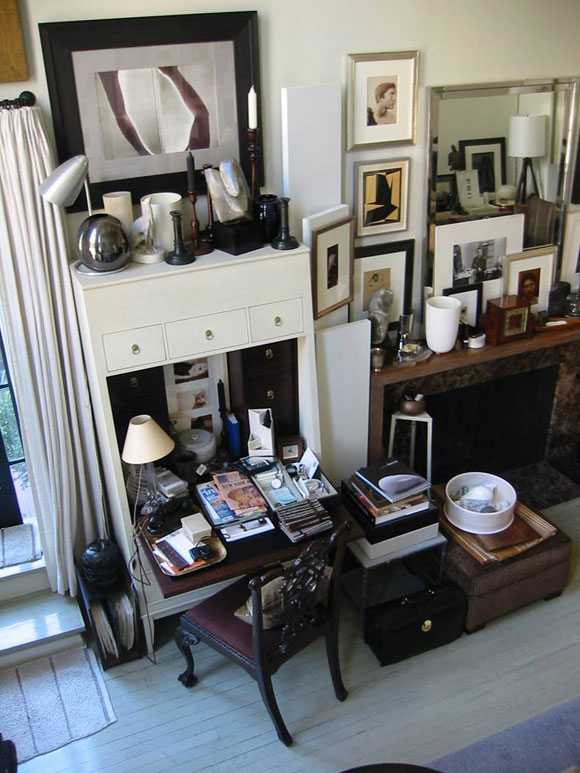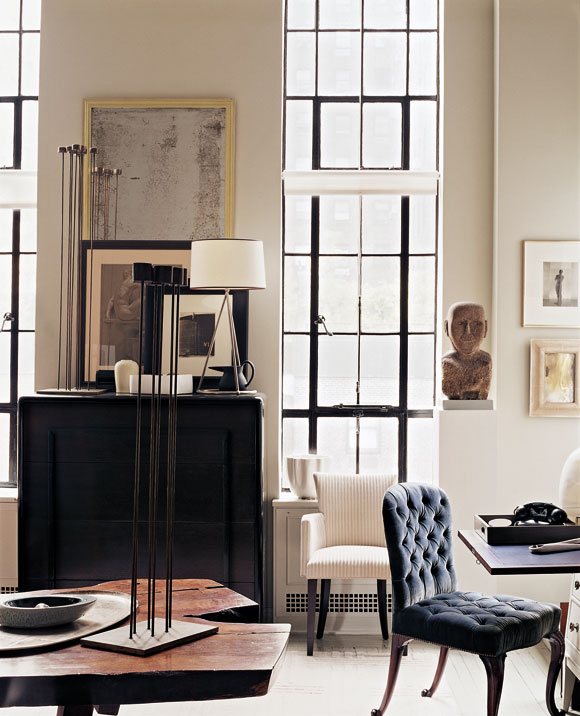Many years ago in the early days of Aero, I was visiting one of my favorite shops – Joel J. Mathieson Antiques in SoHo – and came across a unique set of three very old Chippendale-style side chairs. They had many finely carved details, an elaborate fretwork pattern, a beautiful ornamental paint and velvet seats that all suggested a very fine craftsmanship. However, parts of the chairs were also quite literally collected in a pile of scraps. The backs were broken in many places, springs were poking out, and the loose fragments were all jumbled together like puzzle pieces. There was something charming and special about the set, so I purchased them and ended up using two of the chairs as props in the Aero store and keeping the one in the best condition at my old apartment. Here is an early shot of it at my desk:

The idea of restoring these three chairs didn’t seem necessary to me until I moved into my current apartment. I was keeping the walls bare and the large room sparsely decorated, but I knew I wanted something special to stand next to the modern aluminum and walnut table I had in the archway. The chairs seemed like the perfect choice, so I had them fully restored and reupholstered in an artist linen that I had been keeping around. They ended up not only becoming a focal point of the apartment, but also serving as the inspiration for my Emma Chair for Hickory Chair – the piece that helped launch my very first furniture collection.

When I decided to rethink my apartment and move the bed into the large room and create a kind of artist studio, a lot of changes started taking place. Art started filling up the walls and a few more significant pieces of furniture made their way into the room: a Nakashima dining table, a John Dickinson side table, a pair of Deco chairs, and my Hallings Secretary for Hickory Chair all came together and changed the character of the room. It was a hard decision to make, but I decided to send away the original Emma chairs to make room for something new. For a short while, a George III-style mahogany side chair held the space in front of the Hallings:

However, another visit to Joel’s shop ended up giving the answer. I had bought many items from Joel since the three original Emma chairs, including many pieces of art now hanging on my walls and the ancient Celtic Bust that stands next to my apartment’s large windows. He had an Irish side chair dating to 1750 that immediately drew me in with its size and scale. It was in rough shape – a back leg was broken and the orignal tufted cushioning was coming apart, but it was definitely salvageable. The fact that its heritage was Irish, like my own, was an added charm. I had collected many early English and American pieces over the years but not much from Ireland. Here are two views of it before restoration began:


I took the chair to an antique refurbisher that I trust – someone who also makes many of the custom pieces of furniture for my private clients and who is an expert cabinet maker and antique restorer on the best level. I know he truly appreciates the pieces that are brought to him. The chair was stripped down, the back leg was repaired, and then its frame and legs were polished, though the original patina was retained. At Aero, we are always careful to take record of a piece in its original state before restoration so that we can build it back true to its original scale and spirit, even if we are completely rebuilding it. In this case, all of the original cushioning was carefully saved for the reupholstery phase of the restoration.




I was reminded of the velvet seats of my original Emma chairs and thought about going with a similar color velvet to reupholster the Irish chair. I had a leftover velvet drapery panel from London that had been with me since the beginning of Aero, and even back to my days at Ralph Lauren. There is something great about how velvet is perishable, and I loved the color changing and patina of this scrap piece of drapery. I brought the velvet and the chair to an upholsterer and there was just enough velvet to cover the chair – all that’s left now is the cut-up tail end of the panel:

For the reupholstering, I made sure to stay true to the crispness of the seat and the thin back
of the original.




The chair has a completely traditional form, but the proportions are so fantastic that it feels very current to me. There are beautiful curves and traditional details, but it has a very strong width. The pair of Deco chairs I have in the apartment, upholstered in a cream silk velvet, are more modern than the Irish chair but are also more petite and feel more antique to me in that way.

The restoration of the Irish chair was in a way identical to the restoration of the original Emma chairs. I used scraps – pieces of wood in the case of the Emma chairs and an old piece of velvet in the case of the Irish chair – in order to rebuild something traditional that would compliment and stand out from the more modern pieces in my apartment. The Irish chair even made it to the cover of American Modern – I’m attached to all of the pieces in the apartment in different ways, and its the particular way the parts and pieces mix in my mind that creates the juxtaposition of the modern and antique.



[photos #1, #2, #16 and #18 by Laura Resen]
[Joel J. Mathieson Antiques & Fine Art: 192 Avenue of the Americas, New York, NY 10013
(347) 595-1655]
